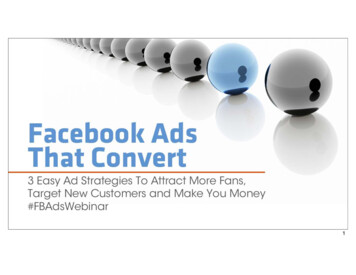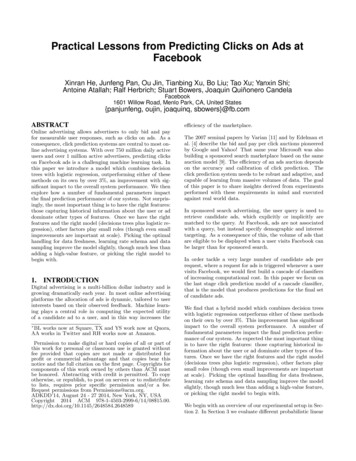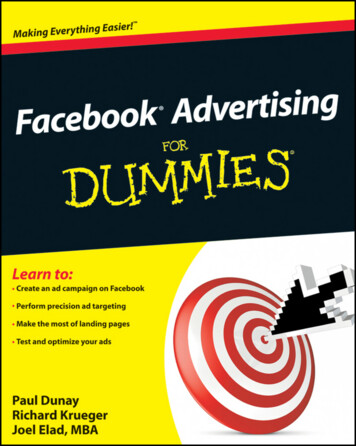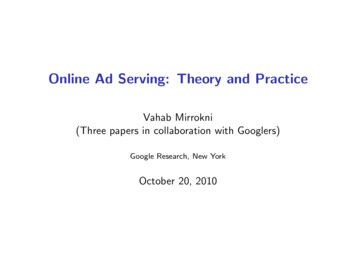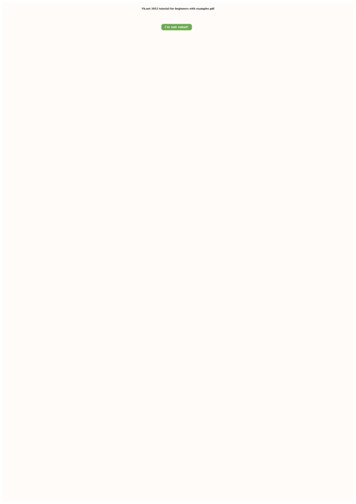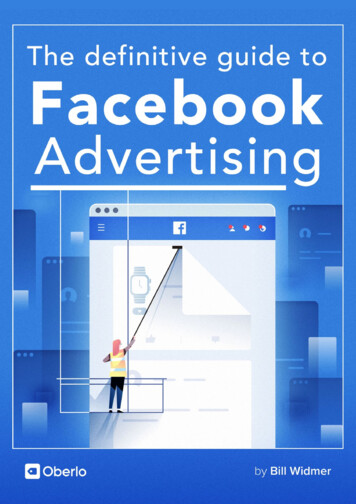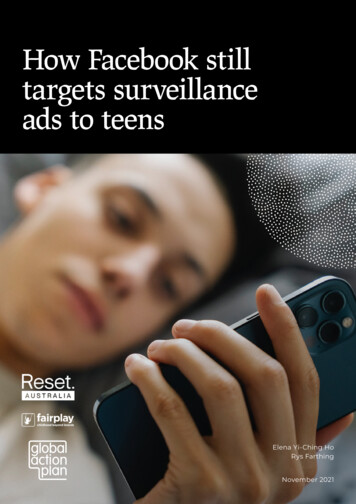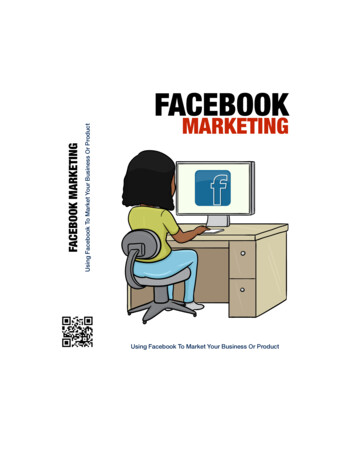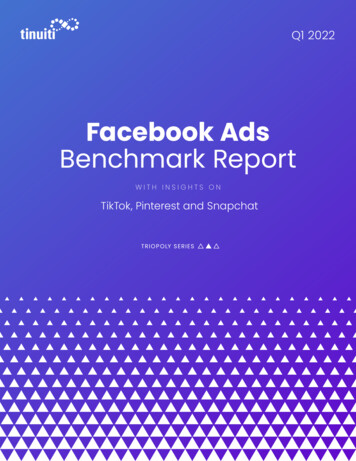
Transcription
Q1 2022Facebook AdsBenchmark ReportWITH INSIGHTS ONTikTok, Pinterest and SnapchatTRI O PO LY SERI ES
Q1 2022Triopoly Series: Facebook Ads Benchmark ReportFacebook AdsBenchmark ReportTable of ContentsFacebook & Instagram GrowthiOS 14.5 FalloutWITH INSIGHTS ONDevices & PlacementsTikTok, Pinterest and SnapchatOther PlatformsTRI O PO LY SERI ESExecutive SummaryMeta ad spend grew 10% year over year in Q1, a meaningful deceleration from the 32% growth observed inQ4 for Tinuiti advertisers, as many brands lapped much stronger year-ago comparisons in the first quarterof the year. Impressions once again declined by double digits, falling 17% year over year in Q1 after a 15%drop in Q4. Growth in ad pricing also slowed, but remained historically strong as auctions continue to behighly competitive.Spend on Facebook proper, excluding Instagram, Messenger and Audience Network, rose 6% year overyear, the slowest growth of the last six quarters. Impressions fell 23% year over year for the quarter,similar to in Q4, but CPM growth decelerated nearly thirty percentage points from quarter to quarter. Adpricing growth will likely continue to slow in Q2 as advertisers run up against much tougher comparisonsthroughout the rest of 2022.Instagram once again outpaced Facebook in spend growth, with ad investment rising 21% year over yearin Q1. However, Instagram impressions fell year over year for the first time ever, and were down 4% in thefirst quarter. The decline occurred despite newer ad placements like Reels and Shop starting to gain moretraction with advertisers.The Instagram Reels placement, only widely released in June 2021, accounted for 2.5% of all Instagramad impressions in Q1, more than double the share observed in Q4. Instagram Shop ads, released globallyin August 2021, accounted for nearly 1% of Instagram impressions. These newer placements will likelycontinue to become more important for advertisers over the coming year.Across Meta platforms, the impact of Apple’s App Tracking Transparency (ATT) update continues to beprevalent in advertising trends. iPhone spend growth entered negative territory in January 2022 for thefirst time since the initial rollout of Apple’s update in April 2021, and stayed down year over year for the firstthree months of the year. Android smartphone spend growth also slowed from previous quarters, but stillaveraged over 50% during Q1 2022, as demand for those users who can still be targeted using mobile IDsremains elevated.2
Q1 2022Triopoly Series: Facebook Ads Benchmark ReportFacebook AdsBenchmark ReportGiven that spend growth for Apple devices has lagged that of Android over the last year, the share oftotal Meta ad spend going to iOS devices has naturally declined since last April, when users startedseeing the ATT prompt with iOS 14.5. The share of impressions coming from devices has remainedstable on Facebook and Instagram, however, as the decline in spend has been driven by iOS CPM trendingmeaningfully lower than that of Android devices since the update. The Audience Network, on the other hand,has seen iOS impression share reduced to just a quarter of what it was in April 2021.Meta widely spoke toWtheI TAudienceH I N SNetworkI G H T specifically.S ONthe detrimental effects of Apple ATT onTikTok, Pinterest and SnapchatIn addition to its impact to advertising, advertisers are also dealing with ATT’s impact to ad tracking, asMeta’s in-platform reporting showed purchases down over 30% year over year in Q1. This is not indicative ofthe change in the true response being driven by ads, but rather the inability of Meta to track some behaviorsafter ad clicks and views for those Apple users who opt out of tracking when presented with the ATT prompt.Marketers will have to continue looking for more holistic methods of measuring performance as well asTRIlimitationsO PO LY SERIES to impede some traditional measures.regularly test for incrementality as trackingcontinueWith Q1 CPM up 37% on Facebook and 27% on Instagram year over year, advertisers are increasinglyexploring additional platforms for cost-effective incremental reach beyond Meta. In Q1 2022, all three ofTikTok, Snapchat, and Pinterest saw advertising CPM at least 30% lower than that of Meta Ads. Ad pricingisn’t a clear indicator of the success of one platform compared to another, but is still one consideration formarketers who are looking to invest more in social advertising.While CPM on non-Meta platforms does trend below that of Meta for many advertisers, competition isstill driving relatively higher prices over time on these platforms. Across TikTok, Pinterest, Snapchat, andLinkedIn, ad pricing rose from January 2022 to March, particularly for TikTok and Pinterest. MethodologyThe Tinuiti Facebook Ads Benchmark Report is based on anonymized performance data from Facebookprograms under Tinuiti management, with annual digital ad spend under management totaling over 3billion. Samples are restricted to those programs that have remained active and maintained a consistentstrategy over the time periods studied. Unless otherwise noted, all figures are based on same-clientgrowth. The trends and figures included are not meant to represent the official performance of Facebookadvertising or the experiences of every Facebook advertiser. About TinuitiTinuiti is the largest independent performance marketing firm across Streaming TV and the Triopoly of Google,Facebook and Amazon, with 3 billion in digital media under management and over 1,000 employees.3
Q1 2022Triopoly Series: Facebook Ads Benchmark ReportFacebook AdsBenchmark ReportWITH INSIGHTS ONTikTok, Pinterest and SnapchatFacebook & InstagramGrowth Q1 2022TRI O PO LY SERI ES4
Q1 2022Triopoly Series: Facebook Ads Benchmark ReportFacebook AdsBenchmark Report Meta ad spend growth slowsto 10% year over year in Q1 asimpressions fall.Meta Ads US Y/Y GrowthAcross All PropertiesQ3 2021Q4 2021Q1 2022 56%source: anonymized Tinuiti advertiser data, 2022Ad impressions declined 17% year over yearacross Meta properties, a deeper decline than 33% 32%the 15% dip observed in Q4 for Tinuiti advertisersand the third straight quarter of negativeWITH INSIGHTSyear-over-year growth. CPM growth slowedmeaningfully from 56% in Q4 to 33% in Q1,but the continued strong growth in this metricindicates that auctions continue to be highlySpendcompetitive, and spend grew 10% year over yearfor Tinuiti advertisers despite tougher year-agocomparisons in Q1.TRI O PO LY SERI ES 40% 33%ON 10%TikTok, Pinterest and SnapchatImpressions Spend growth on Meta’s flagshipapp slows to 6% in the first quarterof the year.Ad spend growth on Facebook, excludingInstagram, Messenger and Audience Network,fell to 6% in Q1 as impressions declined23% year over year. CPM growth came in atthe slowest rate observed in the last fourquarters in Q1, but remained robust at 37%for the first quarter of the year. CPM growthjumped from 6% in Q1 2021 to 44% in Q2,such that advertisers will likely continue to seedeceleration in the year-over-year growth of thismetric moving forward. Instagram ad impression growthgoes negative for the first time.Ad impressions on Instagram fell 4% yearover year in Q1, the first year-over-year declineobserved in this report and a deceleration fromthe 4% positive growth of Q4 2021. This declinecomes despite the recent introduction of newinventory sources like Reels ads, which arestarting to gain traction in impression share.CPM growth also slowed from 37% in Q4 to 27%in Q1, as spend growth fell to 21% in the firstquarter of the year, the slowest growth of thelast six quarters.CPM–5%–15%–17%Facebook Ads US Y/Y GrowthExcluding Instagram, Messenger and Audience NetworkSpend 75%ImpressionsCPMsource: anonymized Tinuiti advertiser data, 2022 50% 37% 25% 6%0%–25%–23%Q4Q12021Q2Q4Q3Q12022Instagram Ads US Y/Y GrowthSpendImpressionsCPM 75% 50% 27% 25% 21%0%–25%source: anonymized Tinuiti advertiser data, 2022Q4Q12021Q2Q3–4%Q4Q120225
Q1 2022Triopoly Series: Facebook Ads Benchmark ReportFacebook AdsBenchmark Report Instagram impressions were 64% more expensive in Q1 2022 than in Q1 2020.CPM on Instagram rose 64% compared to Q1 2020, the highest two-year growth of the last three quarters, as ad auctionsremain highly competitive. CPM rose 46% on a two-year basis for ads on Facebook proper, slowing from 54% in Q4 2021.With ad impressions declining year over year across both platforms in Q1, ad pricing is now the driving force behind adspend growth for the vast majority of Meta advertisers.Meta AdsWUSI TTwo-YearH I N S ICPMG HGrowthT S O byN QuarterFacebook (excluding Instagram, Messenger, and Audience Network)InstagramTikTok, Pinterest and Snapchat 75%source: anonymized Tinuiti advertiser data, 2022 64% 54% 50% 50% 46%TRI O PO LY SERI ES 33% 23% 25%0%Q3 2021Q1 2022Q4 2021 Instagram spend share steady over the last year but up from last Q1.The share of total Meta ad spend going to Instagram rose from 23% in Q1 2021 to 27% in Q1 2022, the same increasein share observed from Q4 2020 to Q4 2021, as Instagram spend growth once again outpaced Facebook proper in Q1.While Instagram spend share has remained stable over the last four quarters, newer placements like Reels and Explore tabinventory stand to help continue the strong pace of spend growth observed on Instagram over the last couple of years.Meta Ads US Spend Share by PlatformAudience NetworkFacebookInstagramMessengersource: anonymized Tinuiti advertiser data, 2022 80% 73% 60% 40% 27% 20% 1% 0%0%Q4Q12021Q2Q3Q4Q120226
Q1 2022Triopoly Series: Facebook Ads Benchmark ReportFacebook AdsBenchmark ReportWITH INSIGHTS ONTikTok, Pinterest and SnapchatiOS 14.5 FalloutQ1 2022TRI O PO LY SERI ES7
Q1 2022Triopoly Series: Facebook Ads Benchmark ReportFacebook AdsBenchmark Report Android smartphone CPM continues to far outpace iPhone CPM for Meta Ads.The cost for Android smartphone impressions exceeded that of iPhones by 46% in Q1, as there continues to be highdemand for those audiences who can still be targeted and tracked via mobile identifiers in the wake of Apple’s ATT update,which limited the use of the IDFA for Apple users who opt out of tracking. While Google announced in Q1 2022 that itintends to build the Privacy Sandbox on Android and that advertising ID for cross-app tracking would be sunset in the future,there was no immediate impact to the use of these IDs with the announcement.WITH INSIGHTS ONMeta Ads US Android Smartphone CPM by MonthRelative to iPhoneTikTok, Pinterest and Snapchat 60% 46% 40%TRI O PO LY SERI ES 20%0%source: anonymized Tinuiti advertiser data, 2022Q22021Q3Q4Q12022 iPhone spend growth declines Y/Y for the first time since iOS 14.5.While ad spend growth for iPhone users across Meta properties has trended well below that of Android smartphonesever since June 2021, it remained positive in year-over-year terms until January 2022 and fell into negative territory forthree straight months to start the year. Android smartphone spend growth also slowed in Q1 relative to prior quarters, butstill ended Q1 at 55% growth for the month of March. Brands will begin to lap the early days of Apple’s ATT update in Q2.Meta Ads US Y/Y Growth by DeviceAcross All PropertiesAndroid Smartphone 100%iPhone 55% 5%8
Q1 2022Triopoly Series: Facebook Ads Benchmark ReportFacebook AdsBenchmark Report iOS share of Facebook spendhit a twelve-month low in March.Meta Ads US iOS Monthly Spend Share by PlatformFacebook Audience Network100%Looking at Meta’s flagship app Facebook,the share of spend attributed to iOS devices75%fell from 58% back in April 2021 to 46% inMarch 2022, as Android devices have becomea bigger part of spend over the same time W I T H 50%INframe. iOS spend share fell from 80% in April2021 to 73% in March 2022 on Instagram, but25%the biggest shift occurred on the AudienceNetwork, where iOS share fell from 51% to just9% over the twelve-month span.FacebookInstagram73%SIGHTS ON46%TikTok, Pinterest and Snapchat0% iOS impression share continuesto hold roughly steady across onFacebook and Instagram.While iOS spend share has declinedmeaningfully across all Meta propertiesover the last year, impression share fromiOS devices has remained roughly steady onFacebook and Instagram. Audience Networkis the one Meta platform that has seen aclear and sustained decline in the share ofimpressions coming from iOS devices, withshare dropping from over 50% in April 2021 tojust 13% in March 2022. Meta’s in-platform purchasereporting continues to suffer inthe wake of ATT.Purchases reported in Meta’s platformcontinued to trend well below pre-ATT levels,with purchases and purchase value bothdown at least 30% year over year in Q1 usingboth 7-day click and 1-day click attribution.Marketers will need to continue to lean onmore holistic methods of measurement, aswell as regularly deploy incrementality testing,in order to truly judge the effectiveness ofads moving forward, as tracking continues tobecome less effective over time with privacyupdates like Apple ATT.9%source: anonymized Tinuiti advertiser data, 2022Apr May2021JunJulAugSepOctNovDecTRI O PO LY SERI ESJan2022FebMarMeta Ads US iOS Impression Share by PlatformFacebook Audience urce: anonymized Tinuiti advertiser data, 2022Apr May2021JunJulAugSepOctNovDecJan2022FebMarMeta Ads In-Platform Reporting US Y/Y GrowthQ1 20227-DayPurchases7-DayPurchase 1-DayPurchases–34%–33%1-DayPurchase –32%–38%9
Q1 2022Triopoly Series: Facebook Ads Benchmark ReportFacebook AdsBenchmark ReportWITH INSIGHTS ONTikTok, Pinterest and SnapchatDevices & PlacementsQ1 2022TRI O PO LY SERI ES10
Q1 2022Triopoly Series: Facebook Ads Benchmark ReportFacebook AdsBenchmark Report Desktop share of Meta Adsimpressions back up to 7% to startthe year.Share of All Meta Property US Ad Impressionsby Device and Access TypeDesktopMobile AppMobile Web1%The share of Meta ad impressions attributedto desktop slipped from 8% in Q3 to 6% in Q4,during a time when many users were on the goduring the holiday season. Desktop impressionWITHshare was back up to 7% in Q1 2022 as userssettled back in to non-holiday season routines.Mobile app usage remained identical from Q4to Q1, and the increase in desktop share cameat the expense of ad impressions shown on themobile web.7%INSIGHTS ONTikTok, Pinterest and Snapchat92%TRI O PO LY SERI ES Reels placements rise to over 2%of Instagram ad impressions in Q1.Reels ads more than doubled from 1.1% ofInstagram ad impressions in Q4 2021 to2.5% in Q1 2022, while the Shop placementaccounted for 0.8% of ad impressionsin Q1 compared to just 0.1% in Q4 2021.Both announced last year, Reels and Shopplacements might currently be smallcomponents of Instagram advertising but havethe potential to drive meaningful incrementalimpressions moving forward, much like Storiesads steadily became an important part ofInstagram ad spend. Marketplace maintains secondhighest ad impression share onFacebook.Marketplace ads accounted for 9% of Facebookimpressions in Q1 2022, identical to Q4 2021and once again the second-highest impressionshare placement behind the primary Feedplacement. Just 2% of Facebook impressionscame from Stories as Facebook Stories hasyet to gain the same traction that InstagramStories have over the last couple of years.Facebook Search ads, which were made widelyavailable in mid-2019, accounted for 3% of all adimpressions in the first quarter of 2022.Instagram Ads US Impression Share by PlacementQ1 2022source: anonymized Tinuiti advertiser data, stagram ShopIGTVFacebook Ads US Impression Share by Placement Q1 2022Excluding Instagram, Messenger, and Audience Network73%source: anonymized Tinuiti advertiser data, n3%2%2%SearchIn-StreamVideosFacebookStories11
Q1 2022Triopoly Series: Facebook Ads Benchmark ReportFacebook AdsBenchmark ReportWITH INSIGHTS ONTikTok, Pinterest and SnapchatOther PlatformsQ1 2022TRI O PO LY SERI ES12
Q1 2022Triopoly Series: Facebook Ads Benchmark ReportFacebook AdsBenchmark Report Pinterest and TikTok ad pricing are up significantly compared to earlier in the year.Pinterest CPM was 48% higher for the median advertiser in March of 2022 than in January, while TikTok ended the firstquarter with CPMs running 39% higher in the last month than the first month, as many advertisers are finding ad auctionsincreasingly competitive on digital platforms. LinkedIn and Snapchat saw more modest CPM growth through March, up8% and 3%, respectively, compared to the first month of the year. With platforms continuing to become more competitiveover time, it’s becoming more important than ever for marketers to deploy best in class creative and campaignmanagement to succeed in social advertising.WITH INSIGHTS ONAd Platform CPM by MonthTikTok,andTinuitiSnapchatRelativePinterestto January 2022 MedianAdvertiserJanuaryFebruary 48%March 52% 39%–3%LinkedIn 8% 16%TRI O PO LY SERI ESPinterest–1%TikTok 3%Snapchat Ad pricing across rival social networks trends below that of Meta platforms.In Q1 2022, the median Pinterest advertiser that was also active in Meta Ads found CPM 44% lower on Pinterest than onMeta platforms, including Facebook, Instagram, Messenger and Audience Network. TikTok CPM came in 39% lower, whilethe smallest CPM difference of Q1 occurred on Snapchat, which was 33% lower than Meta Ads platforms for the quarter.Rising digital ad prices, particularly on Meta platforms, are increasingly driving advertisers to test out opportunitieson newer platforms, though differences in simple CPM don’t indicate the relative success of campaigns. Performancecomparisons are made more complicated by the fact that different social platforms may engage users at different stagesof the purchase funnel.Ad Platform CPM Q1 2022Relative to Meta Ads Platforms Median Tinuiti AdvertiserSnapchat–33%Meta AdsSnapchat–39%TikTok–44%Pinterest13
Q1 2022Triopoly Series: Facebook Ads Benchmark ReportFacebook AdsBenchmark ReportW I T HTHEI N S NEXTI G H T S STEPONTAKETikTok, Pinterest and SnapchatTRI O PO LY SERI ESSchedule Your PaidSocial StrategyEvaluationSchedule a complimentary analysis of your existing paidsocial campaigns and ad strategy to identify areas forimprovement and opportunities for growth.C O N TAC T U S14
The Tinuiti Facebook Ads Benchmark Report is based on anonymized performance data from Facebook programs under Tinuiti management, with annual digital ad spend under management totaling over 3 billion. Samples are restricted to those programs that have remained active and maintained a consistent strategy over the time periods studied.
